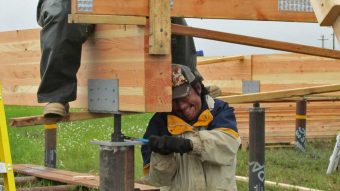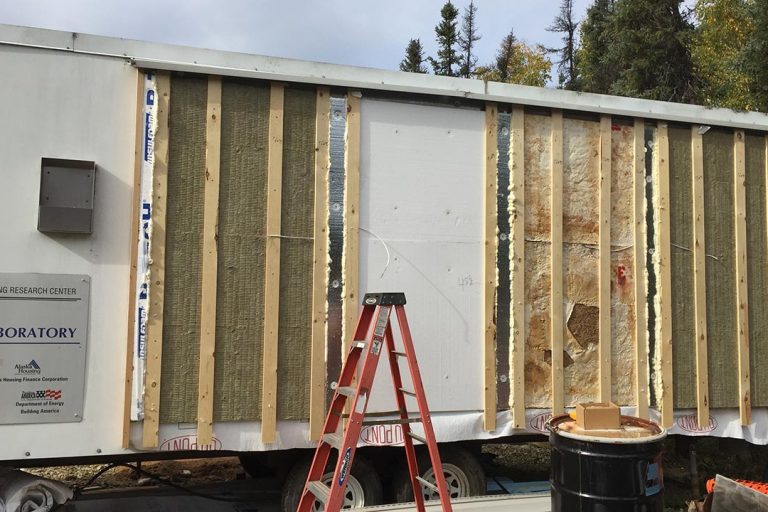Wall Retrofits
Walls make up the greatest surface area of your home. Depending on how well-insulated your current walls are, a wall retrofit may be the best way to achieve deep energy savings. The key to efficient, durable walls is proper moisture management. Cold climate walls are especially susceptible to moisture damage, as moisture from inside the home can force its way into the building envelope, over time leading to mold and rot.
As you go about making your walls more energy efficient, it’s critical to make sure you maintain healthy humidity levels indoors and prevent moisture from being trapped in the walls.
CCHRC has done extensive studies on how various wall retrofit techniques perform in the cold Alaska winter. Some of the most common and cost-effective retrofit scenarios are described below.
Retrofit Options
Adding exterior foam – it’s all about the ratios.
When you add exterior insulation to your walls, you change many things related to moisture control. The extra insulation will slow heat loss through the wall and keep the framing warmer in the winter, but it will also inhibit moisture from escaping in the summer. This balance of moisture buildup in the winter and release in the summer has allowed our homes to work in Interior Alaska and other climate zones.
So if you’re going to block a drying pathway by adding foam, the key is to add sufficient insulation to keep your wall cavity warm enough so that water vapor does not condense on the sheathing. A wall system that achieves this should not have moisture problems, short of plumbing leaks or other major defects.
CCHRC studies have found that retrofitting walls with foam is safest when you follow the ⅔-⅓ rule of thumb. In other words, placing ⅔ (65% or more) of the total wall R-value is outside the sheathing (for example, 6 inches of foam for a 2×4 wall or 8 inches of foam for a 2×6 wall). Walls with less exterior foam (ranging from 59 percent to 30 percent exterior insulation) allowed moisture to accumulate during the winter and/or mold to grow.
Because many residential retrofits have less than 30 percent of the wall R-value outside the sheathing, the durability of the wall becomes largely a function of indoor conditions. In these cases, the potential for moisture damage depends on the quality of a vapor barrier and interior humidity conditions.
Can adding less insulation than this 65 percent mark work in the Interior? Yes, but you’re taking more risk, and counting on humidity and pressure control measures to protect your house for you.
This typically means having a mechanical ventilation system in your home, such as a heat recovery ventilator (HRV). Do you have an HRV? If so, do you maintain it? Your home will thank you if you do. If you don’t, today’s wall retrofit might be creating more work for you than you counted on.
Adding Interior Foam
Lower cost, more disruptive.
If you don’t want to commit to an exterior foam retrofit, another way to boost your efficiency is through adding a thin layer of foam to the inside of the walls.
You should still comply with the ⅔-⅓ rule, by ensuring less than ⅓ of the total wall R-value is placed inside the vapor barrier.
This ensures that the dew point falls outside of the vapor barrier, where you shouldn’t have any issues with moisture and condensation. That means you’re only adding 1-1.5 inches of foam to the inside, which is less expensive than adding a thicker outer layer. For details on this type of wall retrofit, check out this video: Furring in an outside wall.
Cellulose Curtain Wall
A vapor-permeable option.
Another option is to frame a wall outside of your existing wall, called a curtain wall, and fill it with vapor-open insulation like cellulose. This frees you from the ⅔ – ⅓ rule needed for foam, because cellulose allows moisture to pass through.
You need to make sure the home is extremely airtight and that you have a quality vapor barrier on the inside of the home to prevent the walls from being overloaded with moisture.
Related Resources
| Title | Resource Link |
|---|---|
| Cellulose Insulation Snapshot | |
| Durable Envelopes Report | |
| Furring In an Outside Wall | |
| Safe Effective Affordable Retrofits Report | |
| Safe Effective Exterior Wall Retrofits Snapshot: Phase 1 | |
| Safe Effective Exterior Wall Retrofits Snapshot: Phase 2 | |
| Wall Moisture Study in Southeast Alaska | |
| Wall Moisture Study in Southeast Alaska Snapshot |










